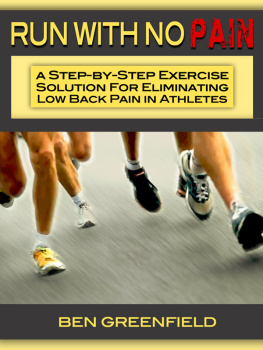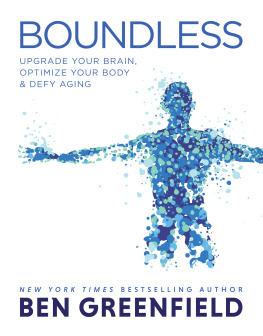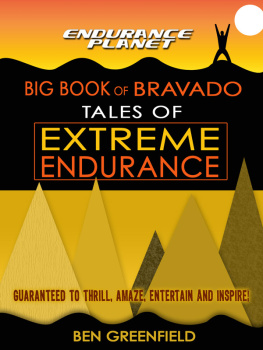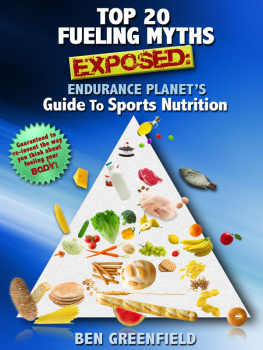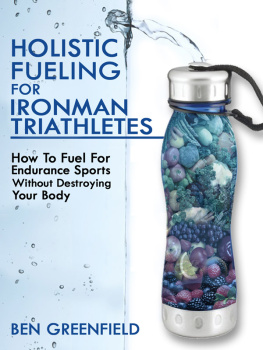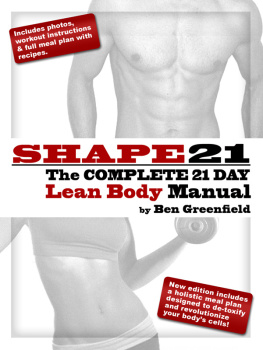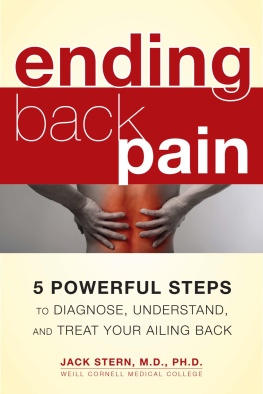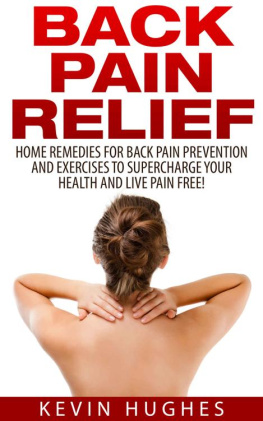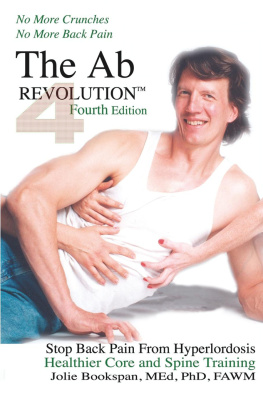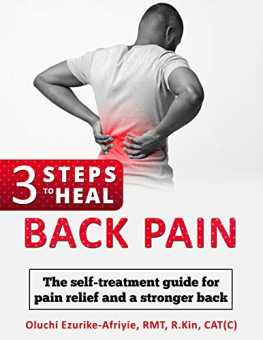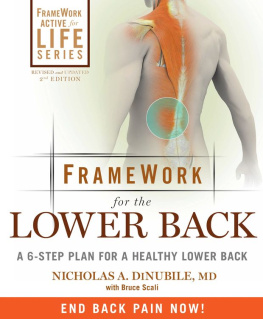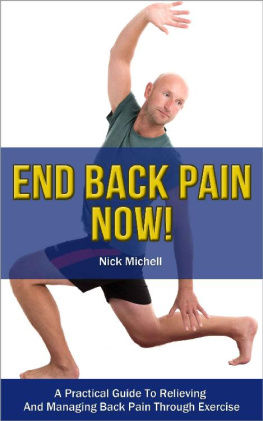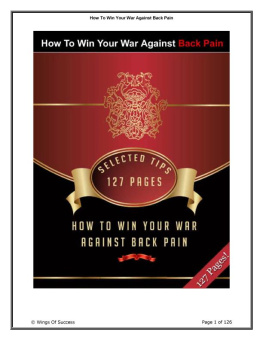Prior to beginning any exercise program, you must consult with your physician. You must also consult your physician before increasing the intensity of your training. The information in this book is intended for healthy individuals. Any application of the recommended material in this book is at the sole risk of the reader, and at the readers discretion. Responsibility of any injuries or other adverse effects resulting from the application of any of the information provided within this book is expressly disclaimed.
Price World Publishing
www.PriceWorldPublishing.com
Copyright 2012 by Ben Greenfield
All rights reserved. Neither this book, nor any parts within it may be sold or reproduced in any form without permission.
eISBN: 9781619841406
Introduction
For the past decade that I've spent as an endurance athlete coach, dozens of my cyclists and runners have experienced debilitating low back pain that limited power production on the bicycle and stride length or push-off while running. Usually the origin of pain was slightly mysterious, and could not be traced back to a single episode of acute injury. Occasionally, the pain was a result of a single injury, such as straining the back while moving a heavy piece of furniture. The pain after this injury never seemed to completely disappear.
This pain was typically described as slightly radiating discomfort, typically located on one side. When cycling and running, the athletes usually experienced a feeling of weakness and nerve tingling on the outside of the knee, only on one side or the other. The pain and slight weakness or tingling tended to manifest most significantly during the following situations:
Sitting for long periods of time, especially with the legs crossed
Riding a bicycle, especially in a bent, aero position
Running, especially on hard surfaces for a long period of time
Certain activities always seemed to slightly relieve the pain (although occasionally they actually seemed to aggravate it). These activities included:
Hip flexor stretching
Hamstring stretching
Yoga
Non-weight bearing exercise like elliptical or swimming
Lying on the back with the feet up
Side-to-side movement
Typically, each athlete described a popping sensation that they could elicit from the back when they twisted from side to side or performed a lying rotational back stretch. Sometimes this also alleviated the pain.
But I wasn't a medical professional. So for many years, I simply coached my athletes through the pain, allowing them to manage the discomfort with chiropracty, acupuncture, massage, and a stiff upper lip.
But one day, while performing the deadlift exercise in a fatigued state with a weight that was perhaps a bit too heavy, I suddenly felt an enormous, ripping sensation pain up and down my entire low back. It was horrible. I spent several months rehabilitating my back and avoiding running, cycling, and any type of heavy lifting.
Eventually, the acute pain disappeared. But over the course of the next several months, I noticed myself experiencing the identical symptoms that my athletes complained about. The tingling on one side while running or cycling, the pain with extended periods of time in the seated position, and the popping sensation in the low back with rotational stretching.
The discomfort severely affected my training and race performance. Desperate to heal my body, I began to research the type of symptoms I was experiencing, speaking with chiropractors, physical therapists, and sport medicine professionals. I learned everything I could about the low back joint, including sacroiliac joint dysfunction, sciatica and piriformis syndrome.
I learned that the sacroiliac joints are considered a source of most low back pain, and compression of the pelvis or an asymmetry of the hips resulted in joint dysfunction and subsequent pain. Compression of the pelvis occurs in the seated position, and rotation of the hips occurs in both cycling and running. An especially significant correlation is noted between low back pain and lack of internal hip rotation mobility.
The development of asymmetry in the hips and improper muscle lengths in the hip rotator muscles can be caused by frequently assumed postures, like sitting for long periods or time or being bent over on a bicycle for hours in the saddle. Typically, this causes the lateral rotation muscles to shorten and the medial rotation muscles to lengthen, and often one side is affected more than the other. When the lateral rotation muscles shorten, the entire hip bone is pulled posteriorly towards the shortened side, thus causing nerve pain that originates from the sacroiliac joint. This pain is aggravated even more during the powerful hip extension movement of cycling and running, during the high compressive spinal forces produced when seated, and during a seated cross-legged position, when the lateral rotation muscles on one side are shortened even further.
I found one excellent resource and studied it from cover-to-cover. It was a book entitled The Malalignment Syndrome, by Wolf Schamberger, and it not only confirmed much of the information I had already acquired, with a very thorough description of low back pain, biomechanical malalignment and improperly rotated hips. But the book was very large, over 450 pages, and I couldn't simply tell my athletes to read the book and figure out how to fix their problem. And I couldn't exactly tuck it under my arm and bring it to the gym every day.
So I gleaned the most practical information from this book, combined it with my research and discussions with medical professionals, and designed a series of exercises and stretches to fix low back pain. Then I set about testing my own methods and theories. For 4 weeks, on at least four to five days of each week, I performed the exact routine that I lay out in this book. It took 15-20 minutes every morning, and I would do it after 5 minutes of light cardio to warm the muscles.
My pain began to disappear. My back quit popping. The weakness and tingling in the side of the leg while running and cycling was no longer present.
So I began suggesting the routine to my athletes, sending them the very same routine that I outline in this book, with instructions on how to perform each stretch or exercise, and instructions to perform the routine every weekday for the next month.
I was amazed at the results.
Within 1 month, every athlete had not only reduced or completely eliminated their low back pain, but the power meter on the bicycle and the lap splits on the run were suddenly showing PR's. The pain had disappeared and the athletes had gotten faster!
Rather than engaging in repeated chiropractic visits and weekly manual adjustments, these athletes were finding that their hips stayed in proper adjustment and the sacroiliac related joint dysfunction was eliminated.
This was definitely worth sharing. I videotaped the exercises and stretches, wrote the workout routine into an easy-to-understand manual, and packed it into an instantly accessible electronic manual entitled "Run With No Pain".
The routine is outlined in the following pages of this document.
"Run With No Pain" is split into two section: "Re-Alignment" & "Foundation". The "Re-Alignment" section is designed to rotate your hips back into proper alignment by stretching and strengthening specific muscles. The "Foundation" section will ensure that these changes are cemented into place with strong and functional muscles and ligaments.
Here's to your health and performance!
Ben Greenfield
MS, CSCS, NSCA-CPT, C-ISSN
Run With No Pain "Re-Alignment"
Basic Overview
The routine outlined on the next page is designed to lengthen, or stretch, the lateral hip rotators and strengthen, or shorten, the medial hip rotators, thus naturally "re-aligning" your hips. This is why you perform certain movements for only one side. It is very important that you do not perform the indicated stretch or exercise for both sides, just the side for which instructions are given. This routine is most effective if you also do the following:
Next page
